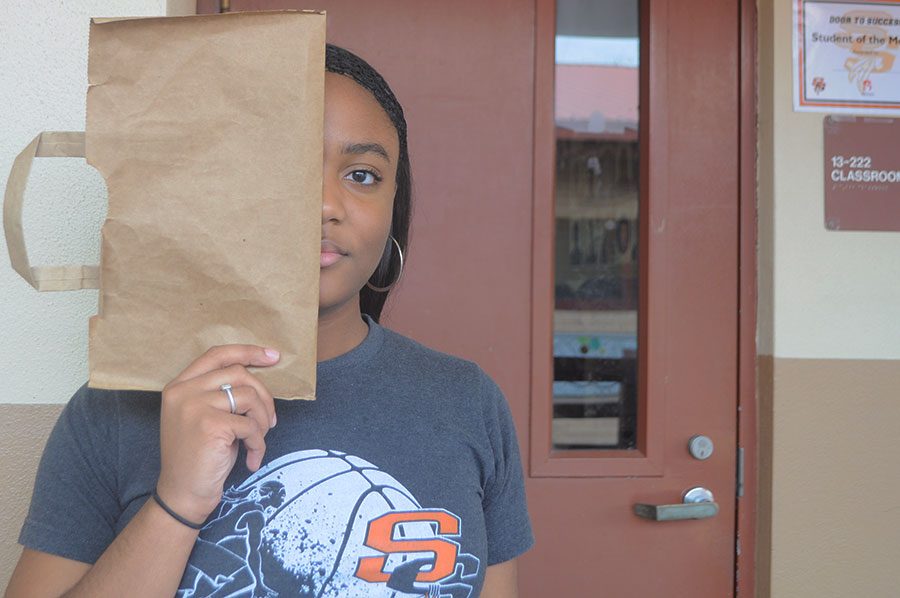COLORISM RUNS RAMPANT IN THE BLACK COMMUNITY
The Brown Paper Bag Test, used during the 20th century, is a form of discrimination based on skin color.
February 16, 2017
With Black History Month celebrating the accomplishments of black people, it is important to recognize the adversity African Americans face to reach their goals, among which is colorism. As more light is shown on the negative effects of colorism, people recognize the need to appreciate and provide representation for darker skin tones.
In a speech about self-love for the Essence Black Women in Hollywood Luncheon, actress Lupita Nyong’o stated, “I remember a time when I too felt unbeautiful. I [ would turn] on the TV and only saw pale skin, I got teased and taunted about my night-shaded skin. And my one prayer to God […] was that I would wake up lighter-skinned.”
Colorism, the prejudice or discrimination against individuals with a darker skin tone, shows its effects in the communities of people of color. Darker skinned people are affected the most through internalized racism. Although colorism is prevalent within all races, it is especially ingrained in US history.
Junior Rosie Waters states, “I wasn’t really made aware of ‘colorism’ until I hit 7th or 8th grade. It was around that time that the whole ‘light-skin vs dark-skin’ mess started. Before then I just thought of myself as me. I hadn’t felt the need to label myself as either but my friend groups did. And I guess you could say my complexion is somewhere in the middle, so I had people darker than me thinking I was ‘all that’ and ‘bougie’ because I was light-skinned and people lighter than me assuming I fit whatever dark-skinned stereotypes there were at the time. It was annoying.”
The roots of colorism comes from slavery. During this time period, black female slaves and white slave-owners frequently bore children, creating mixed race children. These lighter children were considered smarter, prettier, and more capable because of their white ancestry, so they were sometimes given educational opportunities. Lighter slaves were also given the chance to work in the house out of the sun so that their skin did not get darker.
More recently, colorism has been best exemplified through the use of the paper bag test and skin bleaching cream. The brown paper bag test was used within the black community during the 20th century as a type of discrimination in the US. Only people with skin the same color or lighter than a brown paper bag were given privileges such as being a part of sororities, fraternities, or churches.
According to Henry Louis Gates Jr. in The Future of the Race, a Harvard historian, “Some of the brothers who came from New Orleans held a bag party. As a classmate explained it to me, a bag party was a New Orleans custom wherein a brown paper bag was stuck on the door. Anyone darker than the bag was denied entrance.”
Skin bleaching cream is still currently used to lighten one’s skin. The use chemicals for skin bleaching and lightening can be traced back to the use of powders and paint during the Elizabethan era. It is typically used by people of color due the Eurocentric belief that lighter skin is more beautiful.
Sophomore Zy’Reil Sanders says, “At first I thought the brown paper bag test was funny. But then when I really think about it, it shows how ignorant some people are. My step-mom bleached her skin to look lighter and feels like it makes black people think that the whiter you are the more successful you can be. Or the whiter you are the prettier you are and that’s not necessarily true because the blacker the berry, the sweeter the juice.”
Colorism has also been illustrated through common perceptions within black culture. Black parents tell their kids to stay out of the sun or they’ll become “too black/dark” and dark skin girls are given backhanded compliments like “You’re pretty for a black girl.” The mentality of colorism is also expressed through hair standards: looser curls are favored over tighter (4c) hair types. This leads to dark skinned women having to be extraordinarily beautiful compared to average light skinned, racially ambiguous, or white woman, preserving the notion that lighter skin is better.
Waters states, “All hair is good hair! If it grew out of your scalp like that, it’s wonderful! I hate that America loves to use European features as beauty standards. ‘You’re pretty for a black girl’ is something you say if you wanna start World War III. And there’s nothing wrong with black kids getting some sun!”
Although colorism is prevalent in communities of color, many people do not think it is real. It is incredibly important to spread awareness regarding the discrimination people face within their own races.



















